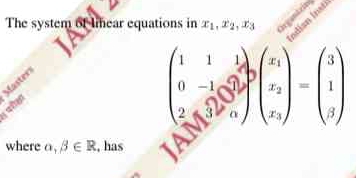The system of linear equations in x1, x2, x3 has conditions involving α and β where α, β ∈ R.

Understand the Problem
The question presents a system of linear equations involving variables x1, x2, and x3, and includes parameters α and β. It seeks to determine the conditions under which this system has a solution.
Answer
Unique solution if $\alpha \neq 1$; infinitely many solutions if $\alpha = 1$ and $\beta = 5$.
Answer for screen readers
The system has solutions under the following conditions:
- Unique solution if $\alpha \neq 1$.
- Infinitely many solutions if $\alpha = 1$ and $\beta = 5$.
Steps to Solve
-
Write the augmented matrix for the system
We need to form the augmented matrix from the given linear equations: $$ \begin{pmatrix} 1 & 1 & 1 & | & 3 \ 0 & -1 & 1 & | & 1 \ 2 & 3 & \alpha & | & \beta \end{pmatrix} $$
-
Perform row operations to simplify the matrix
We'll use Gaussian elimination to simplify the matrix. Start by making the leading coefficient of the second row a pivot.
Subtract 2 times the first row from the third row: $$ R_3 = R_3 - 2R_1 = \begin{pmatrix} 2 - 2(1) & 3 - 2(1) & \alpha - 2(1) & | & \beta - 2(3) \end{pmatrix} = \begin{pmatrix} 0 & 1 & \alpha - 2 & | & \beta - 6 \end{pmatrix} $$
Now the augmented matrix looks like: $$ \begin{pmatrix} 1 & 1 & 1 & | & 3 \ 0 & -1 & 1 & | & 1 \ 0 & 1 & \alpha - 2 & | & \beta - 6 \end{pmatrix} $$
-
Continue simplification
Now, add the second row to the third row to eliminate the leading 1 in the second column of the third row: $$ R_3 = R_3 + R_2 = \begin{pmatrix} 0 & 1 - 1 & \alpha - 2 + 1 & | & \beta - 6 + 1 \end{pmatrix} = \begin{pmatrix} 0 & 0 & \alpha - 1 & | & \beta - 5 \end{pmatrix} $$
The augmented matrix now becomes: $$ \begin{pmatrix} 1 & 1 & 1 & | & 3 \ 0 & -1 & 1 & | & 1 \ 0 & 0 & \alpha - 1 & | & \beta - 5 \end{pmatrix} $$
-
Determine the conditions for solutions
The system has a solution if the last row represents a valid equation. This means we need to look closely at the last row:
- If $\alpha - 1 \neq 0$, then it is a valid equation.
- If $\alpha - 1 = 0$, we require $\beta - 5 = 0$ as well, which gives us $\beta = 5$.
-
Conclusion of conditions
Thus, the conditions are:
- If $\alpha \neq 1$, then the system has a unique solution.
- If $\alpha = 1$, then $\beta$ must be equal to 5 for the system to have infinitely many solutions.
The system has solutions under the following conditions:
- Unique solution if $\alpha \neq 1$.
- Infinitely many solutions if $\alpha = 1$ and $\beta = 5$.
More Information
This system of linear equations often arises in various fields, including physics and economics, where determining equilibrium or optimal solutions is essential. The concepts of linear dependence and independence play a critical role in determining the uniqueness of the solution.
Tips
- Assuming the system has a solution without checking the final equations' consistency for all cases, especially with parameters $\alpha$ and $\beta$.
- Misinterpreting the implications of the row echelon form; remember that having a row of the form $0 = c$ where $c \neq 0$ indicates no solutions.
AI-generated content may contain errors. Please verify critical information